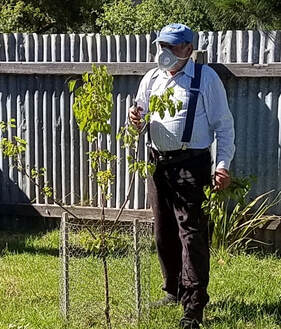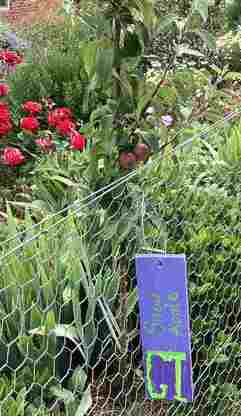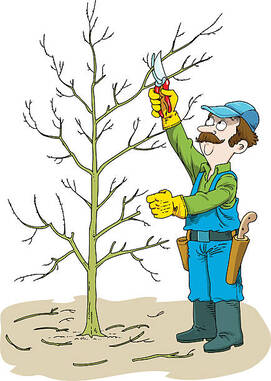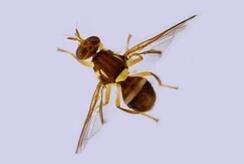Gathering Trail
The Gathering Trail is a plan under the Lismore Progress Association where residents grow fruit trees on their property near the footpath. These trees carry a label to say they are part of the gathering Trail. Walkers are free to pick a piece of the fruit from these trees labelled as they pass by.
As time passes this page will carry updates to the scheme, a map and photos of the trees.
Click here for a map of the trail. Click on each marker for photos and a description.
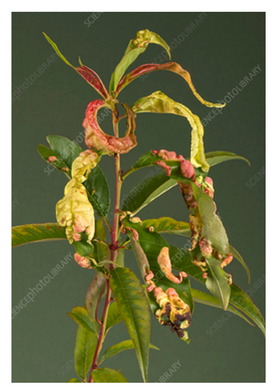
It’s time to tackle Peach Leaf Curl!!
(27 May 2022)
If you have a peach or a nectarine tree, you will certainly be familiar with the dreaded Peach Leaf Curl! If you planted your first peach or nectarine tree last year, then this information is now very important for the health of your tree.
The main symptom of Peach Leaf Curl is red pimple-like deformations on young leaves which, as they grow, become unsightly. It is caused by a fungus which reduces the tree's ability to photosynthesise and fruit abundantly. If left untreated, the problem will get worse year after year, but the good news is, it's a fungal disease that's easily treated.
The fungal spores take up residence over the winter in the nooks and crannies of the tree's bark, but mainly they reside in the leaf bud scales. When the tree breaks bud and comes back into the leaf in spring the new growth gets reinfected, and the cycle starts over again.
Happily, there is a cure for this problem. Several, in fact.
The cure involves spraying the tree THREE TIMES.
If you want to make your own Bordeaux mixture, here is a recipe from Heritage Fruit Trees in Beaufort, where most of our Gathering Trail trees came from:
One of the great advantages of Bordeaux spray is that it can be inexpensively and safely mixed at home with two easily obtainable ingredients, copper sulphate and slaked lime. Many nurseries sell copper sulphate as bluestone while slaked lime is widely available as Limil.
Quite small quantities of ingredients will make many litres of spray. This is just as well as plants should be thoroughly sprayed to the point of runoff.
Bordeaux spray is mixed in two stages. To make a 1% solution dissolve 100 grams of copper sulphate in 5 litres of water in one bucket and 100 grams of limil in 5 litres of water in another bucket. Warm water will help ingredients dissolve more easily. Then, while stirring, pour the lime mixture into the copper mixture. A cloudy blue-coloured liquid results.
The key to successful spraying is straining the resulting mixture through muslin cloth to remove larger solid particles that can block spray nozzles. For best results strain twice. First strain through two thicknesses of muslin cloth when pouring the lime mixture into the copper solution. Rinse the muslin in cold water, fold it over the top of the garden sprayer and pour the complete lime/copper mixture into the sprayer. Remember to continuously stir while preparing and agitate while spraying as the mixture can quickly settle out. It is best used within 24 hours of mixing.
(27 May 2022)
If you have a peach or a nectarine tree, you will certainly be familiar with the dreaded Peach Leaf Curl! If you planted your first peach or nectarine tree last year, then this information is now very important for the health of your tree.
The main symptom of Peach Leaf Curl is red pimple-like deformations on young leaves which, as they grow, become unsightly. It is caused by a fungus which reduces the tree's ability to photosynthesise and fruit abundantly. If left untreated, the problem will get worse year after year, but the good news is, it's a fungal disease that's easily treated.
The fungal spores take up residence over the winter in the nooks and crannies of the tree's bark, but mainly they reside in the leaf bud scales. When the tree breaks bud and comes back into the leaf in spring the new growth gets reinfected, and the cycle starts over again.
Happily, there is a cure for this problem. Several, in fact.
The cure involves spraying the tree THREE TIMES.
- First spraying takes place at leaf fall in late autumn, (late May / early June in Lismore)
- The second one comes just before the blossom buds open in late winter / very early spring, (late July / August – watch your own trees as some varieties blossom earlier than others)
- The third spraying should happen a week or so after the last one. Do NOT spray once the blossoms have opened. It’s too late.
- Copper oxychloride fungicide – available from garden centres / Bunnings
- Lime sulphur fungicide – available from garden centres / Bunnings
- Bordeaux mixture – can be made at home.
- Bagging and binning any affected leaves or fruit.
- Hygiene is important - clean up any leaf, branch or fruit material that accumulates beneath the tree. Spores can overwinter in these materials, reinfecting the tree in spring.
- Growing strong, healthy plants that are well fertilised and watered is the best defence. A healthy plant will be better able to defend itself against pests and diseases.
If you want to make your own Bordeaux mixture, here is a recipe from Heritage Fruit Trees in Beaufort, where most of our Gathering Trail trees came from:
One of the great advantages of Bordeaux spray is that it can be inexpensively and safely mixed at home with two easily obtainable ingredients, copper sulphate and slaked lime. Many nurseries sell copper sulphate as bluestone while slaked lime is widely available as Limil.
Quite small quantities of ingredients will make many litres of spray. This is just as well as plants should be thoroughly sprayed to the point of runoff.
Bordeaux spray is mixed in two stages. To make a 1% solution dissolve 100 grams of copper sulphate in 5 litres of water in one bucket and 100 grams of limil in 5 litres of water in another bucket. Warm water will help ingredients dissolve more easily. Then, while stirring, pour the lime mixture into the copper mixture. A cloudy blue-coloured liquid results.
The key to successful spraying is straining the resulting mixture through muslin cloth to remove larger solid particles that can block spray nozzles. For best results strain twice. First strain through two thicknesses of muslin cloth when pouring the lime mixture into the copper solution. Rinse the muslin in cold water, fold it over the top of the garden sprayer and pour the complete lime/copper mixture into the sprayer. Remember to continuously stir while preparing and agitate while spraying as the mixture can quickly settle out. It is best used within 24 hours of mixing.

